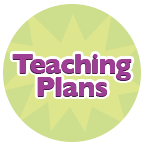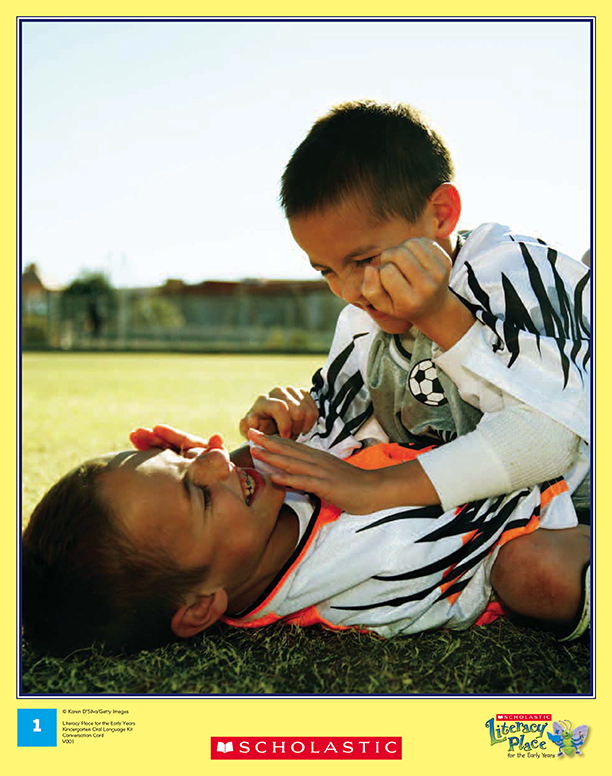Use Open-ended Prompts Use open-ended prompts that invite thoughtful reflections and deeper responses.
Time: one 30-minute lesson or two 15-minute lessons
Materials: Emotions/Interactions Card #1
Grouping: whole class or small group
Assessment: Kindergarten Oral Language Assessment Scale
FOCUSING ON THE PICTURE
[Making connections/inferring/analyzing]-
Show students the picture. Ask them to look at it and think about what they see. Use prompts to stimulate thinking and deepen their observations:
- What is happening in the picture?
- How do you think each boy is feeling? Why?
- Does this remind you of anything you have done?
- After students have had time to closely analyze the picture, have them share their thinking with a partner.
-
Provide time for partner discussion and then select a few students to share their thinking with the group.
[Analyzing/inferring]
- Offer prompts to stimulate discussion:
- Who are the children in this picture? Let’s give them names.
I think the boys in this picture are brothers. I think this because they look alike. I think the boy on the bottom is older because he looks bigger than the boy on the top. I might not be right; I’m just using clues from the picture to help me understand what may be happening in the picture.
Where could they be?- What are they doing? What clues in the picture tell you that?
- Look at the shirts the boys are wearing. How are the shirts the same/different?
- What does this tell us?
- What clues are given in this picture to help us figure out what is happening?
GOING DEEPER
[Inferring/evaluating]
-
Offer open-ended prompts that focus the students on the emotions and interaction portrayed in the picture:
- How is the boy on the ground (bottom) feeling? What clues tell you this? (Help students focus on his facial expressions by asking: What is his mouth doing? His eyes? His hand?)
- How is the boy on top feeling? Why do you think this?
- Why do you think the two boys are wrestling or play fighting?
- Do you think these boys are enjoying themselves? How do you know?
- Have students turn to their partner and think of questions they would like to ask the two boys if they could. Ask each group to decide on one question they want to ask and invite them to share their question with the group. Have the other students answer the question using the clues provided in the picture.
Cameron: We would ask, “What are you fighting about?”
Maelys: We are fighting over who can kick the soccer ball the farthest. I think I can kick it farther than my brother can. He thinks he can kick it farther than me!
Teaching Tip: If this is being done early in the year, model the difference between a question and a story for students by having students ask you questions about yourself to find out more about you.
You may conclude the lesson at this point and do the second part on the next day, or you may decide to continue and do Connecting and Predicting as part of the first lesson.
CONNECTING
Teaching Tip: If you decide to do Connecting and Predicting on the second day, begin your lesson by reviewing the picture with the students.
[Making connections]
- To activate the student’s prior knowledge begin by sharing a personal connection you have about wrestling or play fighting with a sibling or a friend when you were growing up. Prompts might include:
- Have you ever wrestled with your friends or siblings? How did you feel?
- Do your parents like it when you do this? Why or why not?
- Has play fighting ever turned into real fighting? What happened?
How did you feel? How did you solve the problem?
PREDICTING
[Predicting]-
What do you think will happen next? Why do you think this?
Ask students to think about what might happen next in this picture.
-
Brainstorm with students possible scenarios that may occur. Be sure to ask students why they think this will happen to ensure that they are building on the picture and discussions that have taken place.
LESSON EXTENSIONS
-
Use the picture to begin discussions about play fighting and the possible consequences of this type of play. Have children do role-plays about play fighting and share them with the larger group.
-
Create a T-chart listing the pros and cons of play fighting. End the chart with ways to problem solve if play fighting turns into real fighting.
- Use the picture as the basis for a shared writing lesson. Invite students to brainstorm a few sentences about the picture. As you record these sentences, select students to share the pen with you. Have students who are not sharing the pen spell the words out loud or trace the words or initial letters on the floor.
FOLLOW-UP IN CENTRES
-
Display the picture at the writing centre and leave sticky notes and pencils for students to record their ideas. Invite students to stick their notes on the picture. The next day you may wish to use the picture and notes for shared reading or a ‘reading walk’ around the room.
-
At the art centre invite students to paint a picture of a time when they wrestled with a sibling or a friend. Have students tell you or another student about their painting.
-
Using the picture as a starting point, have students use puppets to role-play a scenario in which play fighting turns into real fighting. Model several ways to solve this problem first with students.

